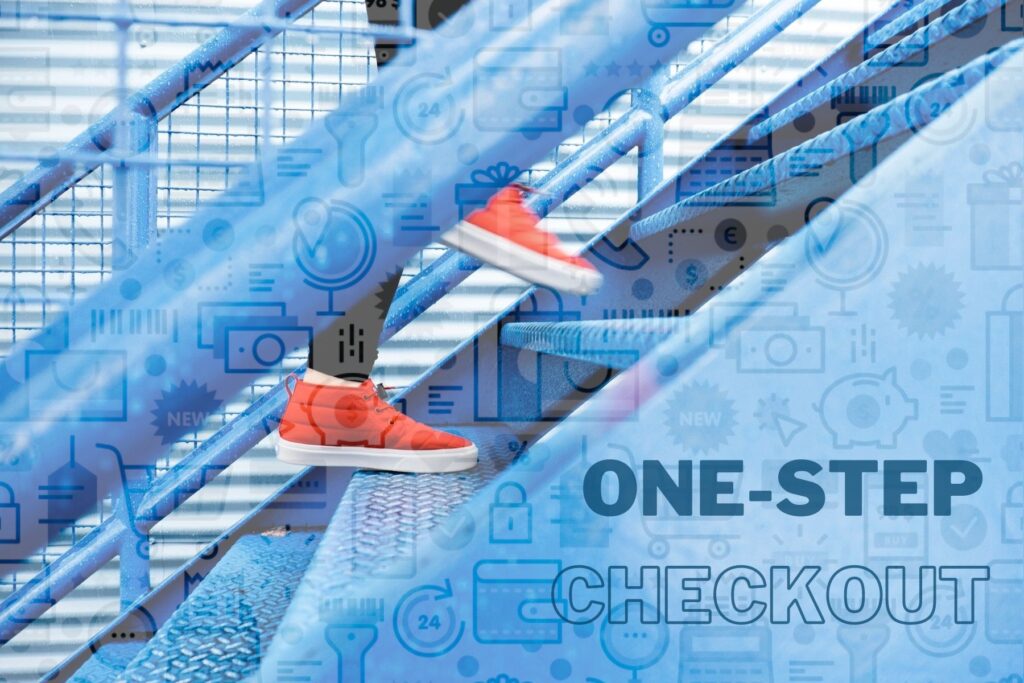Simplifying Online Shopping with One-Step Checkout: Enhancing User Experience
In today’s fast-paced digital landscape, where convenience reigns supreme, every click matters. Imagine a seamless online shopping experience where a single page completes your purchase journey. This concept, known as “one-step checkout,” holds the power to revolutionize the way customers interact with e-commerce platforms.
This article delves into the significance of one-step checkout and why it should be implemented by online stores. We’ll explore how this streamlined approach benefits both shoppers and businesses. Whether you’re a seasoned e-commerce enthusiast or just embarking on your digital retail journey, this discussion holds relevance for you.
With our experience in eCommerce, we’ll unravel the layers of one-step checkout, shedding light on its potential to boost conversions and enhance user satisfaction. Let’s embark on this journey toward a frictionless and expedited online shopping process.
What is One-Step Checkout?

Within the intricate web of an online store, a pivotal element silently orchestrates the symphony of purchases – the one-step checkout. It’s the conduit through which buying decisions crystallize into completed transactions. This ingenious concept condenses the entire order placement process onto a single, crystal-clear page. Odds are, you’ve navigated this user-friendly solution countless times while traversing diverse digital marketplaces.
As commerce embraces relentless digitization, transitioning businesses to the virtual realm, the cardinal rule remains unaltered – don’t complicate the customer’s journey. Much like a brick-and-mortar emporium, the shopper’s intent is simple: pick the item, approach the counter, and wrap up the deal. If you’re steering an e-commerce venture, you’ve probably pondered whether integrating this approach is wise. After all, why disrupt a seemingly functional status quo that keeps loyal customers content and shopping carts intact?
Yet, the allure of one-step checkout is more nuanced than immediate conversion surges. It’s not just an economic catalyst; it’s a customer convenience enabler, akin to the rise of diverse payment methods that once seemed superfluous but are now indispensable.
To grasp its impact, let’s examine a straightforward scenario. Picture two online stores offering identical products at identical prices. However:
– Store A involves a 4-step checkout process, spanning registration, confirmation, and data entry, clocking in at 2-3 minutes.
– Store B champions a one-step, no-account-needed checkout, wrapping up in a swift 40 seconds.
Which shopping cart would likely be abandoned? Unsurprisingly, the elongated one, for online selling thrives on immediacy. Some e-businesses persist with antiquated checkout forms, invoking a sense of frustration. These vestiges of yesteryears hark back to CMS systems of limited integration, necessitating convoluted KYC processes.
The universal question arises – should everyone embrace one-step checkout? Is it a panacea for all industries, or does its potency waver? Here, divergence is possible. In the B2C realm, a single-step approach often slashes cart abandonment rates. However, certain B2B spheres might fare better with multi-step intricacies. Each strategy harbors merits and demerits, awaiting illumination in forthcoming segments of this discourse.
Understanding the Efficiency of One-Step Checkout

Unlocking a realm of user-centric benefits, the implementation of one-step checkout in online stores revolutionizes the shopping landscape:
– Expedited Checkout: With one-step checkout, customers finalize purchases swiftly, minimizing clicks and time investment. This curtails cart abandonment risks, stemming from convoluted procedures.
– Streamlined Interface: Embracing a minimalist interface, one-step checkout diminishes complexity. The ensuing customer journey requires less time and energy, amplifying contentment.
– Frictionless Transaction: Simplifying the buying process, one-step checkout presents users with a seamless flow mirroring traditional transactions. This mitigates perplexity and hiccups during checkout.
– Amplified Conversions: By simplifying and accelerating checkout, one-step checkout breeds higher conversions. This translates into escalated sales and revenue for online businesses.
To actualize this user-oriented vision, meticulous checkout page design is paramount. Simplicity and navigational ease are the cornerstones, alongside lucid directives and conspicuous calls to action. Furthermore, optimizing the checkout page for mobile devices is crucial, considering the upsurge in smartphone and tablet transactions. By nurturing a user-centric ethos and sculpting a checkout experience characterized by speed, simplicity, and user-friendliness, e-commerce platforms can elevate both customer satisfaction and conversion rates.
Increasing Conversion Rate with One-Step Checkout

The benefits of checkout optimization extend beyond conversions. Through tactics like cross-selling and upselling within the checkout flow, businesses can nurture a higher average order value (AOV). This dynamic encourages customers to invest more, generating increased revenue.
To harness the conversion-boosting potential of one-step checkout, meticulous optimization is paramount:
| Amplify Checkout Page Speed | A swift checkout page mitigates cart abandonment risks and bolsters conversions by expediting the transaction process. |
| Transparency in Charges | Transparently presenting charges on the final checkout page establishes trust, reducing cart abandonment rates. |
| Surgical Data Collection | Restrained data collection streamlines checkout, trimming purchase time and effort. |
| Trimming the Purchase Funnel | A concise purchase funnel ensures a seamless shopping experience, diminishing cart abandonment. |
| Diverse Payment and Shipping Options | Providing varied payment and shipping choices heightens convenience and customer comfort, consequently elevating conversions. |
Empirical evidence resounds with the effectiveness of a simplified checkout process:
– According to Shopify, checkout optimization slashes abandoned carts, with 17% of shoppers deserting purchases due to intricate checkouts. Moreover, optimized checkouts correlate with heightened average order values, as strategic cross-selling and upselling techniques trigger greater spending.
– Chargebee accentuates the pivotal role of checkout simplification in boosting revenues and elevating user experiences. Their insights underscore the positive impact of measures like improving checkout page speed, charging transparently, incorporating advanced security, collecting only necessary data, shortening the purchase journey, and diversifying payment and shipping options.
– Rallyon attests to the transformational effect of a streamlined, user-friendly checkout process, reducing abandonment rates and invigorating purchase completions.
– Design nuances are paramount, as affirmed by Quovantis. A checkout page’s aesthetics can shape a transient visitor into a returning customer.
– A UX case study by Well Joe paints a vivid picture of the checkout overhaul for “ShopZone.” By simplifying the process, conversions surged, accompanied by heightened customer satisfaction.
– Yoast‘s perspective on good checkout page UX underscores simplicity, quickness, an uncluttered design, reader-friendly fonts, and a progress bar for navigation.
Meeting Customer Demands for Convenience

Consumer demands for swift and seamless checkout encounters are paramount. Whether opting for online-to-store pickup, using kiosks, or vending machines, the need for convenience shapes the buying journey. Forbes underscores this trend, highlighting guest checkout’s supremacy, with 43% of consumers favoring it. A staggering 72% of these individuals claim they’d forsake their carts if compelled to create an account. The checkout phase, a pivotal juncture in the consumer odyssey, merits meticulous attention. A well-crafted, intuitive checkout process curbs abandonment rates, paving the way for transaction completion.
In step with contemporary preferences, the one-step checkout model emerges as a beacon of efficiency. Its streamlined structure harmonizes with modern customer expectations. This approach doesn’t just abbreviate the checkout sequence; it redefines the customer experience. Fewer clicks and quicker completions alleviate the cart abandonment menace induced by elongated procedures. Moreover, one-step checkout orchestrates a seamless buying journey, encompassing all transaction facets, reminiscent of a traditional checkout. By harmonizing the checkout process, integrating the one-step checkout paradigm, e-commerce platforms can effectively elevate conversions, minimize cart abandonment, and cultivate heightened customer satisfaction.
Best Practices for Implementing One-Step Checkout
Efficiently integrating a one-step checkout requires adherence to these guiding principles:
1. Prioritize Simplicity: Simplicity reigns supreme. Craft a one-step checkout that’s intuitively simple, equipped with lucid instructions and prominent calls to action. Furthermore, optimize the layout for mobile devices, given the prevalence of smartphone and tablet transactions.
2. Embrace Transparency: Forge transparency by openly presenting charges on the final checkout page. This fosters trust and mitigates cart abandonment, bolstering customer confidence.
3. Selective Data Gathering: Collect only the data you truly need. This streamlines the checkout journey, minimizing the time and effort customers expend to finalize their purchase.
4. Trim the Purchase Funnel: An abbreviated purchase funnel translates to a more fluid shopping experience. Reducing complexity curtails cart abandonment, elevating the likelihood of transaction completion.
5. Diverse Payment and Shipping: Enhance customer convenience and comfort by offering an array of payment and shipping options. This versatility contributes to higher conversions.
6. Harness Progress Indicators: Incorporate a progress indicator to navigate customers seamlessly through the checkout process, reducing uncertainty.
7. Constantly Refine: The journey towards optimal one-step checkout is continuous. Regularly test and fine-tune the process to unearth areas for enhancement, subsequently boosting conversions.
By embracing these best practices, e-commerce platforms can adeptly infuse the one-step checkout mechanism, enriching the online shopping endeavor for their valued clientele.
Conclusions
In the dynamic world of e-commerce, where success hinges on meeting evolving customer demands, the role of one-step checkout emerges as pivotal. The inherent advantages paint a compelling narrative: expedited checkouts, user-friendly layouts, seamless transactions, and heightened conversions. These advantages collectively sculpt a journey of customer satisfaction and business prosperity.
As the digital landscape transforms, customer expectations evolve in tandem. To remain competitive, businesses must not only understand these expectations but also align their strategies accordingly. This is where the transformative power of one-step checkout surfaces, offering a cutting-edge solution that reflects the modern buyer’s preferences. By simplifying and accelerating the checkout process, businesses assert their commitment to a user-centric approach, ensuring a seamless and efficient shopping journey that resonates with the contemporary shopper.
Amid this transformative journey, Default Value emerges as an indispensable ally. With a proven track record of optimizing online store checkouts and enhancing user experiences, we possess the expertise to guide businesses through this transition, facilitating not just implementation, but also ensuring its alignment with broader business goals. So, let’s embark on this journey together, armed with the strategic advantages of one-step checkout, as we steer our businesses to new horizons of growth and customer satisfaction.




